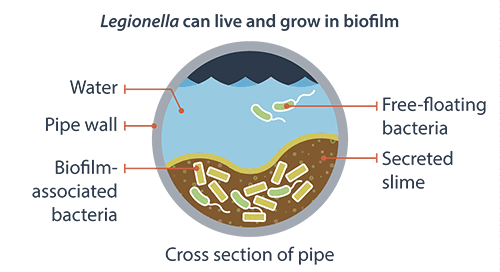Legionella are bacteria that we really don’t want to have in our bodies. They are pathogens of diseases and can lead to infections, particularly in people with weakened immune systems. Because they spread in pipes with drinking water, it is important to keep an eye on their habitat and the quality of our drinking water.
Did you know that there are millions of tiny little creatures, invisible to the human eye, hanging around in the water in your pipes? We’re talking about legionella and other bacteria. Standing water and a temperature of between 25 and 50 degrees Celsius are the perfect conditions for such bacteria to multiply unnoticed.
NO FEAR OF LEGIONELLA

Legionella are bacteria that can cause disease. When you shower, they are rinsed out of the shower head in tiny water droplets. Legionella enter the lungs in water via the respiratory passages. In healthy people, they are unlikely to cause illness. But people with a weakened immune system can become infected with legionnaires’ disease.
To protect yourself against being infected with legionnaires’ disease and to maintain the high quality of the drinking water, it is important to fully exchange the tap water after a long period of non-use. “Our drinking water has to be replaced after 72 hours at the latest, otherwise the water in the pipes quickly becomes a paradise for germs and bacteria such as legionella,” says Beat Aebi, Product Manager Piping Systems International at Geberit.
BEAT AEBI’S TIPS FOR LOW-LEGIONELLA DRINKING WATER
- Legionella die off in temperatures over 50 degrees Celsius. This is why it is important to keep an eye on the temperature in your boiler and make sure it is always over 50 degrees.
- If you have been away from home for a while, we would recommend you don’t drink water straight out of the tap. Rather, you should flush all drinking water pipes in your (holiday)home for about two minutes. This particularly includes taps and shower sprays. Avoid being in the bathroom when the water is running.
- Legionella can also nest directly at the point of use. This is why you need to regularly free shower sprays and tap aerators – the nozzles on the taps in the kitchen and bathroom – from limescale. Simply unscrew them, allow them to soak in a commercially available descaling agent and reattach them after cleaning. This is how to guarantee a consistently high drinking water quality.
- Taps are potential collecting points for legionella and other bacteria. Therefore, have taps that are (mainly) unused, such as those in the laundry, dismantled. Outdoor taps should be sealed off over the winter. Caretakers and plumbers can ensure that there is no more water in the relevant section of the drinking water pipe.
- For home owners, it is well worth their while to have a plumber regularly test – and if necessary replace – the domestic water filter. In an apartment building, it is usually the caretaker who is responsible for testing and replacing the filter to ensure high drinking water quality.
- If the incidence of legionella is high, it could well be worth your while to use a temporary sanitary flush unit – such as the Geberit Rapid sanitary flush unit. Without any major conversion work and without great expense, it can be fitted at the relevant section of the pipe to ensure the quality of your drinking water again.


